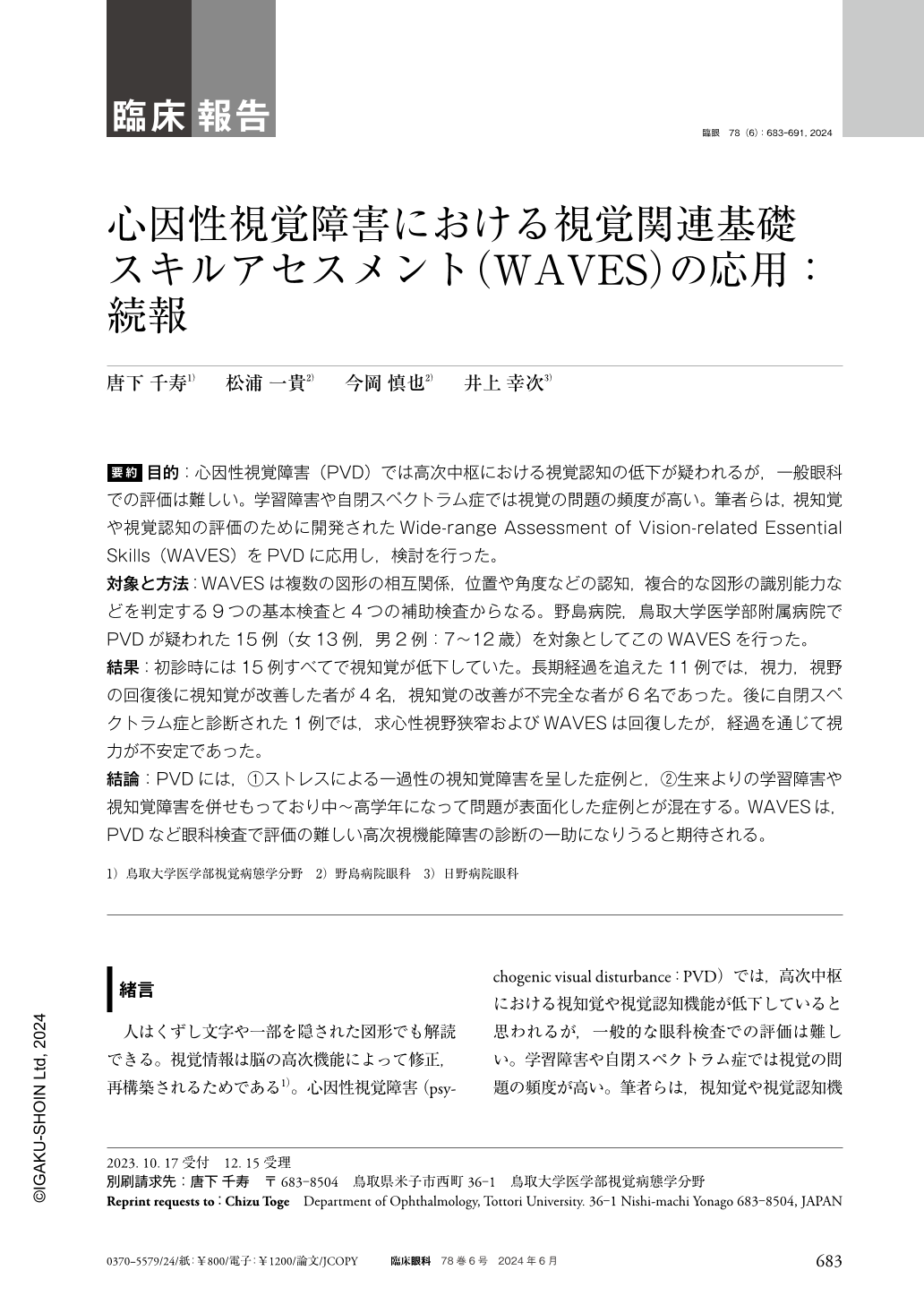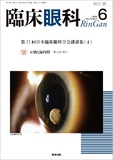Japanese
English
- 有料閲覧
- Abstract 文献概要
- 1ページ目 Look Inside
- 参考文献 Reference
要約 目的:心因性視覚障害(PVD)では高次中枢における視覚認知の低下が疑われるが,一般眼科での評価は難しい。学習障害や自閉スペクトラム症では視覚の問題の頻度が高い。筆者らは,視知覚や視覚認知の評価のために開発されたWide-range Assessment of Vision-related Essential Skills(WAVES)をPVDに応用し,検討を行った。
対象と方法:WAVESは複数の図形の相互関係,位置や角度などの認知,複合的な図形の識別能力などを判定する9つの基本検査と4つの補助検査からなる。野島病院,鳥取大学医学部附属病院でPVDが疑われた15例(女13例,男2例:7〜12歳)を対象としてこのWAVESを行った。
結果:初診時には15例すべてで視知覚が低下していた。長期経過を追えた11例では,視力,視野の回復後に視知覚が改善した者が4名,視知覚の改善が不完全な者が6名であった。後に自閉スペクトラム症と診断された1例では,求心性視野狭窄およびWAVESは回復したが,経過を通じて視力が不安定であった。
結論:PVDには,①ストレスによる一過性の視知覚障害を呈した症例と,②生来よりの学習障害や視知覚障害を併せもっており中〜高学年になって問題が表面化した症例とが混在する。WAVESは,PVDなど眼科検査で評価の難しい高次視機能障害の診断の一助になりうると期待される。
Abstract Purpose:Decreased visual cognition in the higher central system is suspected in cases with psychogenic visual disorders(PVD). However, the evaluation of visual cognition by general ophthalmologic examinations is difficult. Visual problems are common in children with learning disabilities and autism spectrum. We previously reported two children with PVD aged 9 and 10 years in which the Wide-range Assessment of Vision-related Essential Skills(WAVES)was applied to evaluate visual perception and visual cognitive function. Herein, we added more cases and re-examined the usefulness of WAVES in the diagnosis of PVD.
Materials and methods:WAVES consists of 9 basic tests and 4 auxiliary tests. This test scale determines the interrelationship of multiple figures, recognition of positions and angles, and ability to discriminate complex figures. In this study, 15 patients(13 girls, 2 boys aged 7-12 years)suspected of having PVD at Nojima Hospital and Tottori University were enrolled.
Results:Visual perception was impaired in all 15 patients at the first visit. Of the 11 patients available of long-term course, 4 had improved visual perception, and 6 had incomplete improvement in visual perception after the recovery of visual acuity and visual field. In one patient who was later diagnosed with the autism spectrum, concentric contraction of visual field and WAVES recovered;however, the visual acuity was unstable throughout the course.
Conclusions:PVD includes cases of transient visual perception disorder caused by stress and cases of inborn learning disability or visual sensory deficits that were not noticed in early childhood, but problems emerged in the middle grades of elementary school.
WAVES is expected be useful for the diagnosis of higher-order visual dysfunction, which is difficult to evaluate in general ophthalmologic examinations.

Copyright © 2024, Igaku-Shoin Ltd. All rights reserved.


